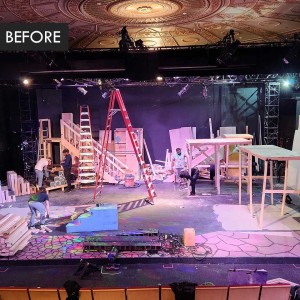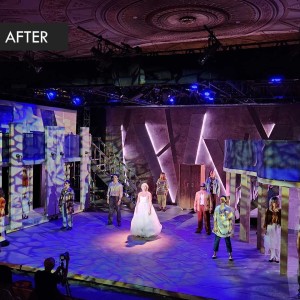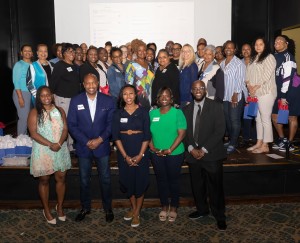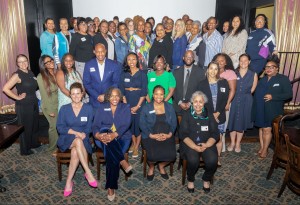NNV Program Plays Small Role in Solving the Mystery behind an Iconic Photo
Written by Stephanie Chong, originally published on Northwest Neighbors Village
It’s not all that unique to hear stories about members and volunteers making connections from the common threads they’ve discovered from getting to know one another. But it is not every day that these connections make it to the front page of the Washington Post! Such was the case when a Northwest Neighbors Village (NNV) program became the catalyst in solving the mystery behind an iconic photo taken 50 years ago.
“Five decades ago, a dozen friends gathered here, on the National Mall, for breakfast. They wore morning coats and floor-length dresses, dined on oysters, drank champagne, and danced together as a string quartet played in the shadow of the Lincoln Memorial. The extravagant scene on July 19, 1974, drew in a Washington Post photographer, who captured the moment in an image that would ricochet around the country in newspaper reprints,” reported the Washington Post.
“But the people and circumstances at the center of that famous picture remained a mystery… until Joyce Naltchayan Boghosian — the daughter of late Post photographer Harry Naltchayan, who captured the original image — met one of the participants a year ago and began to put the pieces together.”
“I was one of the ‘diners’ at the breakfast.” Betsy saw NNV’s promotion for Joyce Boghosian’s program Photos from Beirut to the White House: A Father-Daughter Legacy. Upon seeing the award-winning photographer Harry Naltchayan mentioned, Betsy signed up. She knew of Harry. He had taken the photo that hangs in her dining room. The one of her and her friends at a birthday breakfast on the National Mall. Betsy reached out to NNV with an email that included the image and a note to share with Joyce informing her that she was in the photo that Joyce’s father had taken. This moment of serendipity led to the telling of a beautiful story about friendship and legacy.
“I can’t tell you how amazing this has been ever since the NNV event that you invited me to.” Joyce had been captivated by the photo, and had always been curious about the story behind the image. After the NNV talk, Joyce and Betsy got in touch and the story began to unfold. The extravagant breakfast on the Mall, which included engraved invitations, a meal catered by Avignon Freres (the premier caterer of the time), and the guest of honor’s arrival by horse and carriage, was coordinated by a group of friends who had a penchant for organizing elaborate birthday parties for one another. This particular event was in honor of their friend Janet. It was such an unusual site that it caught the eye of Washington Post photographer Harry Naltchayan. To the great surprise of this group of friends, the image of their breakfast made local and national news!
“A day when no other news occurred.” Betsy shared that friends and family from all over the country sent newspaper clippings to the group that was photographed that day. Janet created scrapbooks for her friends, compiling the news stories, the invitation, the National Park Service permit that allowed them to host the affair, and even a letter from the head waiter, Mac. The material in the scrapbooks would provide invaluable in helping to recreate the photo 50 years later where the friends sat in their respective seats. Sadly, some seats were empty, including the one at the head of the table that belonged to Janet who died of breast cancer at a young age.
“Thank you for your friendship and celebrating this beautiful story.” Joyce was there for the recreation of the photo, including other new participants like the head waiter Mac’s daughters. With the table set and everyone in their places, Joyce Boghosian recreated her father’s iconic photo 50 years later. The breakfast attendees in the photo have remained lifelong friends, celebrating birthdays and Thanksgiving for decades.
“The impact of the Village is beyond what anyone could have imagined!” We were in touch with Betsy and Joyce after the story ran in the Post. Having played a small role, NNV was humbled to be mentioned. Both women felt that the connection made through the NNV program was pivotal in retelling their story. Betsy said, “It wouldn’t have happened without you.” Our sincerest thanks to Betsy and Joyce for sharing their story with us, and to NNV volunteers David Cohen and Jan Solomon whose role in planning the program sparked a series of events that led to something very special.
Northwest Neighbors Village is a local nonprofit and member-driven organization that envisions a generous, supportive, inclusive community where all older adults are valued, age with dignity, and enjoy opportunities for growth and engagement. Learn more about the programs, resources, and volunteer support they offer to empower older adults in Washington, DC. You can also watch a recording of their program that started this one-year journey to bring Harry Naltchayan’s image back to life.



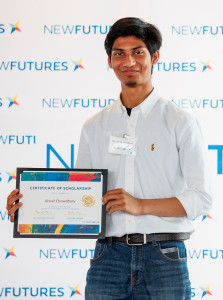


 “I think there is a lot of room for growth and it is an opportunity for me to take interest in other areas of experience,” said Nadia Dennis, another BroadFutures DC intern. During her internship this past summer, she supported various types of project management projects and initiatives at CBRE, a global leader in commercial real estate services and investments, and also a long-time BroadFutures supporter and employer partner. “One thing I have learned so far at my internship is the logistical details of leasing and property management tasks, and I like that because it is not my area of interest or studies… I look forward to taking skills into future workplaces.”
“I think there is a lot of room for growth and it is an opportunity for me to take interest in other areas of experience,” said Nadia Dennis, another BroadFutures DC intern. During her internship this past summer, she supported various types of project management projects and initiatives at CBRE, a global leader in commercial real estate services and investments, and also a long-time BroadFutures supporter and employer partner. “One thing I have learned so far at my internship is the logistical details of leasing and property management tasks, and I like that because it is not my area of interest or studies… I look forward to taking skills into future workplaces.”